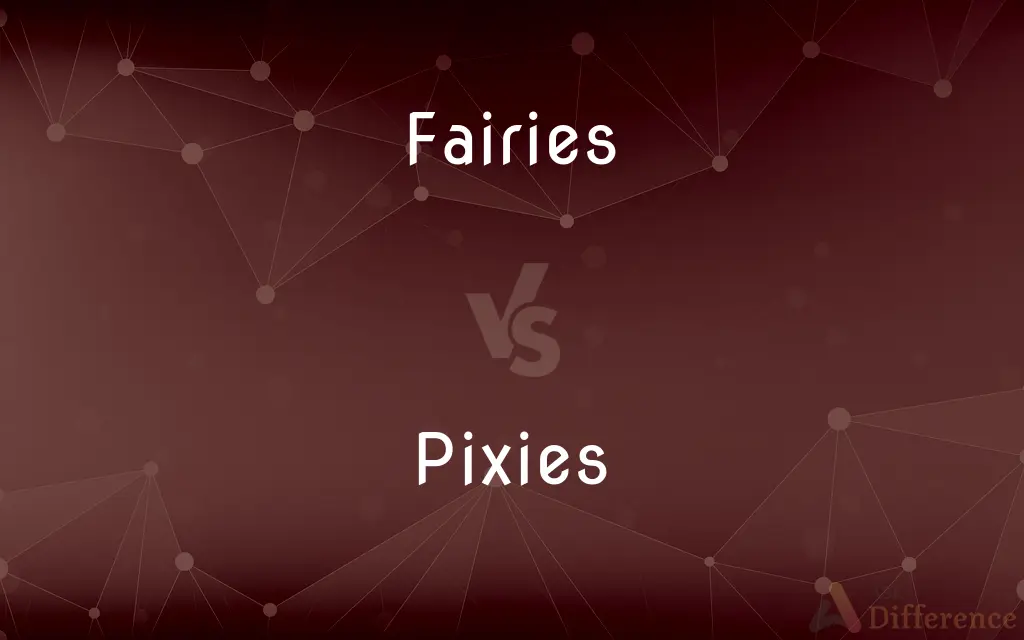Fairies vs. Pixies — What's the Difference?
Edited by Tayyaba Rehman — By Fiza Rafique — Published on November 26, 2023
Fairies are mythical beings often depicted with magical powers and human-like forms. Pixies are smaller, playful sprites primarily from Cornish folklore. Both are associated with nature but have distinct characteristics.

Difference Between Fairies and Pixies
Table of Contents
ADVERTISEMENT
Key Differences
Fairies and Pixies, both rooted in folklore, have enchanted many over the years. Fairies, found in various mythologies, are often imagined as larger, human-sized beings possessing magical powers. They can be both benevolent and mischievous. Pixies, on the other hand, are primarily linked with Cornish tales and are typically viewed as smaller, childlike sprites known for their playful nature.
Throughout literature and film, Fairies often hold higher statuses in mythical hierarchies, sometimes seen as guardians or rulers. They can influence the human world in profound ways, often tied to the elements of nature or human emotions. Pixies, while also tied to nature, are more localized in their influence, engaging in small pranks or leading travelers astray in the woods.
Physical attributes between Fairies and Pixies also tend to differ. Fairies are often visualized with elegant wings resembling those of butterflies or moths and have a radiant glow about them. Pixies might not always have wings, and when they do, they're often more like those of dragonflies or beetles.
Many cultures around the world have tales of Fairies, with variations in their roles, appearances, and intentions. These beings can be protectors, adversaries, or sometimes neutral parties to human affairs. Pixies, more region-specific, emphasize a more light-hearted interaction with the world, often characterized by their whimsical nature.
Comparison Chart
Origin
Various mythologies worldwide
Primarily Cornish folklore
ADVERTISEMENT
Size
Often human-sized
Typically smaller, childlike
Role in Tales
Guardians, rulers, influencers of human world
Playful sprites, often pranksters
Physical Attributes
Butterfly-like wings, radiant aura
Sometimes wingless, or with beetle-like wings
Interaction with Humans
Can be protectors, adversaries or neutral
Whimsical, might lead travelers astray
Compare with Definitions
Fairies
Mythical beings with magical powers and often human-like forms.
The children believed that fairies danced in the meadow at night.
Pixies
Small, playful sprites predominantly from Cornish legends.
Cornish locals often speak of pixies playing tricks on unsuspecting visitors.
Fairies
Characters in folklore who can either aid or thwart human endeavors.
He was warned not to upset the fairies living near the ancient tree.
Pixies
Entities believed to inhabit ancient hills and wild places of Cornwall.
Legend warns of pixies guarding the ancient stones against intruders.
Fairies
Imaginative representations of magical beings in various cultures.
Some say that fairies are the spirits of forgotten ancestors.
Pixies
Representations of the more light-hearted side of mythical folklore.
On midsummer's eve, you might catch a glimpse of pixies dancing under the moon.
Fairies
Supernatural entities often associated with nature and elemental forces.
Legend says that fairies control the wind and rain in this forest.
Pixies
Mythical creatures known for leading travelers astray with their mischief.
If you get lost in these woods, it might be the pixies leading you on a wild goose chase.
Fairies
Ethereal creatures depicted with wings and an aura of magic.
In her dream, she was visited by a fairy with luminescent wings.
Pixies
Characters often depicted without wings but possessing a whimsical nature.
She found her shoes filled with flowers, a sure sign of pixie mischief.
Fairies
An imaginary being in human form, depicted as clever, mischievous, and possessing magical powers.
Pixies
A fairylike or elfin creature, especially one that is mischievous; a playful sprite.
Fairies
Offensive Slang Used as a disparaging term for a gay man.
Pixies
Playfully mischievous.
Fairies
Plural of fairy
Pixies
Plural of pixie
Fairies
Plural of fairie
Common Curiosities
Are Fairies always kind and benevolent?
No, Fairies can be both benevolent and mischievous, depending on the story.
Do both Fairies and Pixies have wings?
While Fairies typically have wings, Pixies might not always have them.
Why are Pixies often associated with laughter?
Pixies are depicted as whimsical beings, often laughing and playing tricks for amusement.
Can Fairies grant wishes?
In some tales, Fairies have the power to grant wishes, but the outcomes may vary.
What kind of pranks do Pixies play?
Pixies are known for playful pranks like leading travelers astray or hiding objects.
Are Fairies and Pixies the same?
No, Fairies and Pixies have distinct characteristics and origins, though both are associated with nature.
Where did stories of Pixies originate?
Pixies are primarily associated with Cornish folklore in England.
Are Fairies found only in European folklore?
No, variations of Fairies appear in folklore worldwide, though names and attributes may differ.
How are Fairies usually represented in art?
Fairies are often portrayed with elegant wings, human-like forms, and a magical aura.
Can humans interact with Fairies and Pixies?
In folklore, humans often interact with both, though the consequences of these interactions vary.
Do Pixies have a particular place they call home?
In many tales, Pixies inhabit ancient hills, wild places, or specific landmarks in Cornwall.
Are there male and female Fairies and Pixies?
Yes, both Fairies and Pixies can be depicted as male, female, or without specific gender.
Share Your Discovery

Previous Comparison
L Glutamine vs. Glutathione
Next Comparison
Aggregate vs. CumulateAuthor Spotlight
Written by
Fiza RafiqueFiza Rafique is a skilled content writer at AskDifference.com, where she meticulously refines and enhances written pieces. Drawing from her vast editorial expertise, Fiza ensures clarity, accuracy, and precision in every article. Passionate about language, she continually seeks to elevate the quality of content for readers worldwide.
Edited by
Tayyaba RehmanTayyaba Rehman is a distinguished writer, currently serving as a primary contributor to askdifference.com. As a researcher in semantics and etymology, Tayyaba's passion for the complexity of languages and their distinctions has found a perfect home on the platform. Tayyaba delves into the intricacies of language, distinguishing between commonly confused words and phrases, thereby providing clarity for readers worldwide.
















































